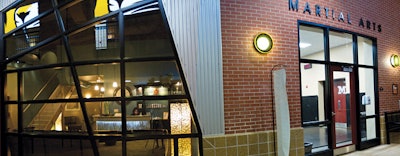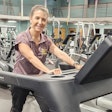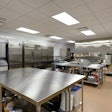
After the long years of planning and construction, and shortly after the excitement of the grand opening, your brand new recreation facility will begin to age. This is a hard fact of life in the business of building and/or renovating popular places. That first cracked tile or tiny chip on the counter by the entrance is like the first scratch on a brand new car. It's only a matter of time before it happens.
Recreation facilities are high-traffic buildings. They are going to be cracked, chipped, scratched, dinged, worn and torn starting on the day the doors open. One can look at much of the wear and tear as evidence of user love. However, there are specific preventative steps that can be taken to keep a recreation facility looking like new every day regardless of how long ago operations commenced. Here are 10 tips for keeping your facility grand well beyond its opening.

EVALUATE YOUR PROGRAM STATEMENT ANNUALLY.
The program statement shaped your facility from the very beginning. It informed the architects and the builders about what to build for your constituents, as well as how the spaces would be used. If your program statement does not accurately reflect how you operate or use a space today, the space will become obsolete. Review your program statement every year to make certain that all of your spaces are relevant to how you currently operate. The retail industry knows that to stay fresh — stores must have a five- to seven-year plan to update and re-energize existing spaces. Do not be afraid of experimenting with and repurposing existing, underutilized space. Be bold.

PLAN FOR WEAR AND TEAR.
Nothing ever stays looking new forever. Yet, users expect a facility to look new regardless of its age or popularity. Certain features and spaces within a facility are prone to higher use than others and will show wear and tear regardless of your preventative efforts. Entry walk-off mats, the finish on certain doors, the edges on countertops and the corners of walls in popular pathways can all show early signs of aging. In wet areas, toilet seats, hand sprayers and showerheads are particularly susceptible. In workout areas, it's the pads and upholstery on benches and machines, rub points on handgrips, and stripes on the track.
Predicting which areas will wear most is as simple as observing current conditions in similar facilities and identifying high-impact spaces. Note how long it takes for facility elements to begin to show wear, then document for future reference and corrective action. How long did it take between new mats merely showing wear and looking worn out? Was it 36 months? Less? Include in your notes the cost of repair and replacement to bring the facility element back to 100 percent.

CHOOSE MATERIALS THAT CAN WITHSTAND HIGH-IMPACT USE.
It's standard practice that everything within reach in a typical recreation center needs to be extremely durable. Extending weight room flooring up the wall 30 inches protects against damage from free weights. Corner guards common in hospital design can protect high-traffic areas such as equipment issue and storage rooms, or anywhere moving carts might be used. Concrete masonry units (cinder blocks) are commonly specified in areas of greatest potential impact, including gymnasiums, multi-activity courts and natatoriums. However, escalating facility construction costs have led more architects to specify drywall as an alternative to block, and to install high-impact drywall to a height of 10 feet above the floor — coated with an easy-to-clean paint.
Think higher, too. Ceilings, high walls, sprinkler heads, light fixtures and speakers all need to be selected carefully and protected from flying balls and other projectiles.

SELECT FINISHES THAT WILL BE EASY TO CLEAN AND VISUALLY FORGIVING
Visit existing facilities and talk with recreation and custodial staff members, who will know what products are surviving the wear and tear of their facility. Trendy material choices may not be your best option, particularly if there is no cleaning history for that new product. Minimize joints in floor tile to reduce spaces that might fill with crud. Always select a darker mortar for those joints, since light-colored mortar shows dirt immediately. Choose a matte-finish tile with a remark or slight "potters' touch" finish. Such tile can be slip-resistant even in shower and locker areas and its surface never appears water-spotted. Consider running the jogging track surface up the wall 24 inches so joggers won't leave shoe marks when they stop to stretch their calves and ankles.

ALLOCATE FUNDS IN THE OPERATING AND CAPITAL BUDGET FOR REFRESHING SPACES ON A REGULAR SCHEDULE.
The project budget — including furniture, fixtures and equipment (FF&E) — is only the beginning of the financial story. Small improvements and repairs should be planned for in the annual operating budget. In some cases, annual operating budgets can be used to step up into larger capital refreshing and remodeling projects.
Many national brand contracts are set at 10 years. As a result, many dining venues use a 7- to 10-year planning and remodeling schedule for updating the look and function of their spaces. Recreation facility managers should consider this same model for keeping their spaces relevant in both operations and style. In addition to planning for regularly scheduled updating, the guts of the facility operating system and any major remodeling projects should be considered and included in a long-range capital plan spanning 10 to 20 years.
Be certain to do this exercise regardless of funding status. Whether there are available dollars or not, everything has a life expectancy. Plan for aesthetic and functional relevance of five, 10, 15, 20 years and beyond, and update the document annually.

ESTABLISH A PERSONAL DESKTOP REFERENCE GUIDE.
This is the all-important notated contact list of who installed various facility elements and features. These are details that fade away over time but are important to know should you need to reference past work in a particular space. Who were the various engineers and subcontractors? Who was your finish carpenter? Who was the lead electrician?
This becomes your go-to guide when the electric shades get hung up and the breakers begin to trip. Include everything from the carpet and tile suppliers to where the block was manufactured. Each large-scale project typically comes with a hefty reference guide; however, it will be more effective and efficient if you create your own contact list for fingertip reference.

DISCUSS THE LIFECYCLE AND LIFE EXPECTANCY OF FINISHES AND FIXTURES DURING THE PLANNING PHASE.
Double-check your information during construction in case changes are made. The construction process is notorious for product substitution after a project is bid and under construction. You and your design team should review every request, since issues of maintenance, durability and warranties may be significantly altered. Substituted products may look like equals but perform very differently in your new facility.

PAY ATTENTION TO WARRANTIES AND PRODUCT LIMITATIONS.
Be prepared to fully investigate product and installation warranties, and seek out opportunities to extend warranties if possible. Some products and facility elements may weaken or even fail over time. Do not be surprised to learn how many products in your new facility are warranted only for one year. Have your design team, facilities personnel and recreation staff participate in a one-year facility review (11 onths after substantial completion) to look for any products showing early failure or unusual wear before warranties expire.

DEVELOP AN AGGRESSIVE CLEANING PROGRAM.
It is essential to clean the facility with a strong emphasis on details every day. Accumulated grime and grit can lead to wear and premature aging. A single day missed cleaning a recreational facility is like a week of neglect in any other building. There is a critical difference between standard custodial care and specialized housekeeping when cleaning general spaces and custom features and furniture. Routine daily cleaning, maintenance cleaning and regularly scheduled deep cleaning are critical for keeping your building looking and smelling like new. Certain types of maintenance can be outsourced to local specialists — professional scrubbing of tile and grout biannually, power-washing entry sidewalks, washing windows and other types heavy cleaning.

MAINTAIN ADEQUATE ATTIC STOCK.
Finishes, carpet styles, paint colors, and tile sizes, colors and shapes typically cycle out of production every few years. Common styles and colors — even best-sellers — undergo subtle changes that make matching difficult. Aggressively maintain plenty of attic stock to keep pace with seamless improvements, well-matched repairs and replacements. Review attic stock annually and keep in touch with vendors who supply these materials so that you can be informed when something in a product line is being phased out. If at all possible, designate an attic stock space within your facility that you can secure and control. There are many sad tales of facility attic stock maintained offsite disappearing against all assurances to the contrary.
The old saying "An ounce of prevention is worth a pound of cure" is especially true when planning for wear and tear in a recreation facility. Once a new building is open, maintaining the look is a daily endeavor that will pay annual dividends for years to come.
Erik Kocher ([email protected]) is a principal/owner at Hastings + Chivetta Architects in St. Louis. Diane Dahmann is the former executive director of MizzouRec Services and Facilities at the University of Missouri.
This article originally appeared in the June 2014 issue of Athletic Business under the headline, "Keep It Up."




































